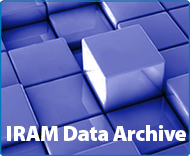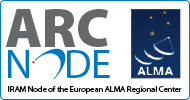News
Multiple fibers in the heart of the Orion star-forming region
.jpg) |
A unique combination of ALMA and IRAM 30-meter observations reveals the internal gas structure in Orion with unprecedented detail. The new data show that the gaseous material in this star cradle is highly organized forming a wispy network of filamentary structures prior the formation of stellar embryos.
An international team led by Dr. Alvaro Hacar from the Leiden Observatory (The Netherlands) has investigated the formation of stars in the vicinity of the famous Orion Nebula Cluster. Located only 1300 light-years away, Orion is one of the nearest star-forming regions, and the only one containing massive stars. As prototype of its class, the Orion Nebula Cluster is often used as a benchmark to test most current star-formation theories. This new work is part of the ORION-4D project, an ambitious observational program aiming to characterize the formation mechanisms within this star-forming region.
The new study, published in the A&A journal, used complementary observations from two of the most powerful radioastronomical observatories in the world, the ALMA interferometer in Chile and the IRAM 30-meter telescope in Spain. The authors combined the improved resolution provided by ALMA together with the high-sensitivity of the IRAM 30-meter observations to produce one of the largest high-resolution maps obtained so-far with this technique.
Hacar and collaborators investigated the cold and dense gas in the Orion Nebula Cluster using observations of the emission of diazenylium molecules (N2H+) at millimeter wavelengths. The combined ALMA plus IRAM 30-meter data shows a breathtaking view of the filamentary nature of the star-forming material around this cluster. In their analysis, the authors identified a total of 55 dense fiber-like gas structures forming a complex network.
These new results provide crucial information to interpret the formation of both solar-like and massive stars in our Galaxy. Using previous IRAM 30-meter observations, the same team identified similar networks of fibers in more quiescent clouds forming stars in isolation. There, Hacar and collaborators demonstrated that the fragmentation and collapse of these fibers give rise to most of the new solar-like stars. The new detection of fibers in Orion suggests that a similar mechanism operates in the formation of the more massive stars.
Fibrous gas substructure around the Orion Nebula Cluster. This dramatic image shows the emission detected by the combined ALMA plus IRAM 30-meter observations, shown in red, in comparison with the infrared emission provided by the VLT HAWK-I camera of this same region. The fiber-like gas substructure contrasts with blue emission emerging from the young and massive Trapezium stars. Credit: ESO/H. Drass/ALMA (ESO/NAOJ/NRAO)/A. Hacar: http://eso.org/public/news/eso1809/
.png) |
| Total integrated N2H+ (diazenylium) emission maps obtained from the combination of ALMA plus IRAM 30-meter observations (central panel) compared to previous continuum observations (left panel; Johnstone & Bally 1999) around the Orion Nebula Cluster. The 55 fiber-like structures identified by Hacar and collaborators are highlighted by red segments in the right panel. (Hacar et al 2018, A&A, 610, A77) |
The authors involved in this project were Alvaro Hacar (Leiden Observatory, The Netherlands), Mario Tafalla (Observatorio Astronomico Nacional - IGN, Spain), Jan Forbrich (University of Hertfordshire, UK), Joao Alves, Stefan Meingast, Josefa Grossschedl (IfA-Vienna, Austria), and Paula Stella Teixeria (University of St. Andrews, UK).
More information:
For additional information contact A. Hacar (hacar@strw.leidenuniv.nl)
Additional information can be found in the accompanying ESO Photo Release (http://eso.org/public/news/eso1809/)
The A&A paper is available here (Hacar et al 2018, A&A, 610, A77)(http://adsabs.harvard.edu/abs/2018arXiv180101500H).
Click here to know more about the ORION-4D project (https://sites.google.com/site/orion4dproject/home).
The data products of this project are available in the following link (https://sites.google.com/site/orion4dproject/data)



